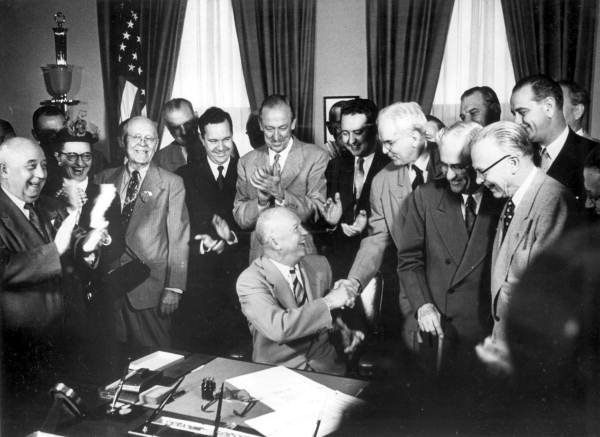Petersen Archive | Dwight D Eisenhower — Petersen Automotive Museum
[ad_1]

The postwar era was a time outlined by unprecedented prosperity. Following the 2nd Environment War, returning GI’s came dwelling to a booming economic system, housing advancement assignments, and guidance plans like the GI Invoice that expanded and cemented America’s center course. By 1950 most factories, such as automobile companies, had made the changeover from wartime creation to a purchaser-centered financial state, so a lot so that, in that calendar year by itself, 8 million autos have been developed, by 1958 far more than 67 million cars would be produced and registered in the United States. Having said that, at the start of the 10 years, most of America’s out of date streets were in no ailment to help a large inflow of targeted traffic. Force for design of transcontinental superhighways experienced been rising considering that the late 1930s, however, conflict concerning urban interests and rural interests vying for precedence and a absence of funding left early assignments these kinds of as the 1944 Federal-Assist Highway Act lifeless in the water. By the 1950’s, in get to handle an inflow of new car homeowners president Dwight D. Eisenhower publicly supported an interstate freeway advancement application and on June 29, 1956, he signed the Freeway Revenue Act also identified as the Nationwide Interstate and Defense Highways Act into law. The act marked the major American community functions plan of that time authorizing the design of 41,000 miles of interstate highways fitted with overpasses and restricted-entry belt strains. Eisenhower experienced been closely affected by his ordeals in 1919 as a participant in the U.S. Military's initial Transcontinental Motor Convoy throughout the United States and his observations of the German audubon highway network throughout World War II. Having regarded the significance of mobility and effectiveness, Eisenhower proposed an American interstate freeway program in his State of the Union deal with in 1954, which he framed as a nationwide defense method. In an exertion to stimulate a cooperative alliance between condition and federal officials, retired General Lucius D. Clay, an engineer and a extensive-time advisor to the president, proposed a prepare in which the federal governing administration would pay out 90 percent of the value of expressway design the funding for which would arrive from an enhanced gasoline tax (now 3 cents a gallon). Interstate funds ended up to then be distributed in the ratio of each individual condition's estimated expense of finishing the technique. The very first challenge underneath the Act was the Mark Twain Expressway (Interstate 70) in St. Charles County, Missouri.
The highways were intended to reduce site visitors congestion swap “undesirable slum locations with pristine ribbons of concrete” as one highway advocate set it make coast-to-coast transportation more effective and make it uncomplicated to evacuate major cities in circumstance of an atomic assault. Even though transformative, the Freeway Revenue Act also mirrored an enduring legacy of Jim Crow period discriminatory policies and systemic racism. Low-cost mortgages via the G.I. Bill (which was not supplied to black GI’s), enabled white people to abandon inner cities in favor of suburban housing as effectively as avoid ethnic minorities from doing the same. Federal planners of the interstate highway procedure routed some highways specifically, and generally purposefully, through predominantly black and brown neighborhoods to predominantly white suburban neighborhoods. Despite the fact that the Freeway Profits Act was at first fulfilled with common general public support, as far more folks grew to become displaced and ailments in cities deteriorated, activists began to brazenly oppose the system, some going as considerably as forcing building stoppages through the late 1950s and early 60s. Through the 1960s, civil legal rights activists and environmentalists across the state in New York Town, Baltimore, Washington, D.C. New Orleans and other metropolitan areas managed to prevent roadbuilders from dividing and subjugating their neighborhoods, at some point however, most of the 41,000 miles of interstate were finished.
Sources:
https://www.senate.gov/artandhistory/historical past/minute/Federal_Highway_Act.htm#:~:text=On%20June%2026%2C%201956%2C%20the,Eisenhower%20signed%20it%20into%20legislation.
https://www.npr.org/2021/04/07/984784455/a-temporary-background-of-how-racism-shaped-interstate-highways
https://www.theatlantic.com/company/archive/2016/03/position-of-highways-in-american-poverty/474282/
https://highways.dot.gov/community-roads/summer time-1996/federal-help-highway-act-1956-producing-interstate-method
[ad_2]
Supply backlink








